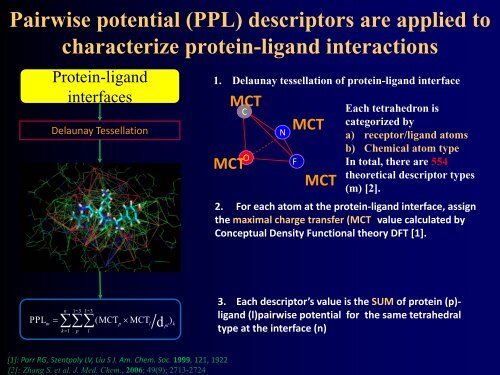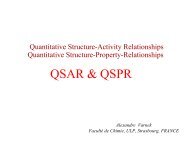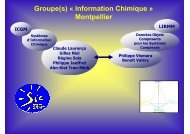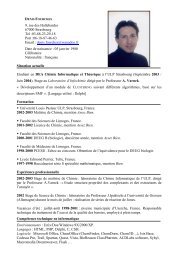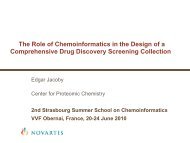Best practices for chemical data curation and QSAR model ...
Best practices for chemical data curation and QSAR model ...
Best practices for chemical data curation and QSAR model ...
Create successful ePaper yourself
Turn your PDF publications into a flip-book with our unique Google optimized e-Paper software.
[1]: Parr RG, Szentpaly LV, Liu S J. Am. Chem. Soc. 1999, 121, 1922<br />
[2]: Zhang S. et al. J. Med. Chem., 2006; 49(9); 2713-2724<br />
Pairwise potential (PPL) descriptors are applied to<br />
characterize protein-lig<strong>and</strong> interactions<br />
Protein-lig<strong>and</strong><br />
interfaces<br />
Delaunay Tessellation<br />
1. Delaunay tessellation of protein-lig<strong>and</strong> interface<br />
C<br />
MCT<br />
MCT<br />
O<br />
N MCT<br />
F<br />
MCT<br />
Each tetrahedron is<br />
categorized by<br />
a) receptor/lig<strong>and</strong> atoms<br />
b) Chemical atom type<br />
In total, there are 554<br />
theoretical descriptor types<br />
(m) [2].<br />
2. For each atom at the protein-lig<strong>and</strong> interface, assign<br />
the maximal charge transfer (MCT) value calculated by<br />
Conceptual Density Functional theory DFT [1].<br />
PPL<br />
n 1~3<br />
1~ 3<br />
m<br />
= ∑∑∑(MCTp<br />
× MCTl<br />
d )<br />
pl k<br />
k = 1 p l<br />
3. Each descriptor’s value is the SUM of protein (p)-<br />
lig<strong>and</strong> (l)pairwise potential <strong>for</strong> the same tetrahedral<br />
type at the interface (n)


